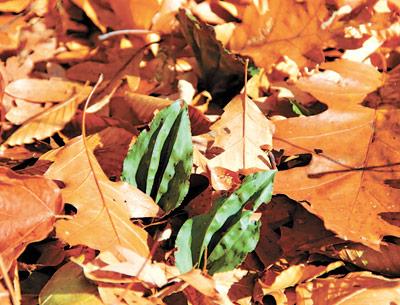Nature Notes: Treasures in the Woods

Woods, before Lyme disease, were the child’s other playground. Shimmy up trees, play cops and robbers, hide and seek, and all the time aware of the trees, leaves, bushes, open spots, learning ecology without knowing it.
I entered such a woods on the first day of November. The scarlet oaks were still ablaze in a plethora of shiny reds, the ground underfoot was covered with freshly loosed leaves and almost as pretty, leaves were spinning and turning over as they fell like snow, it was a magical childhood moment even for this 78-year-old writer.
The South Fork is full of woods of different kinds and different colors. There is Hither Woods or, as Dan Rattiner used to refer to it, “the Great Spooky Woods,” Point Woods in view of the Montauk Light, the Stony Hill Woods in Amagansett, Northwest Woods, west of Three Mile Harbor, the Wainscott pine barrens, which cross the border into Southampton, the morainal woods in north Bridgehampton and Water Mill, the North Sea-Tuckahoe woods, which end in the Shinnecock Hills, and countless smaller patchy ones scattered here and there.
But I was on the North Fork, which is covered with farmland and all of its woodland if taken together — from Jamesport on the west to Orient Point on the east — would barely equal Hither Woods in size. I was in the largest of the North Fork’s motley assemblage, Moore’s Woods in the Village of Greenport, named after an early Southold Town settler. It can’t be bigger than a few hundred acres, but it has almost everything that a woods should have, and much that no woodland on the South Fork has.
Moore’s Woods was oft-visited by Long Island’s most revered naturalist, the late Roy Latham, who lived on a potato farm in Orient. Roy covered all of eastern Long Island, on foot, on horseback, in Tin Lizzies, and, in the last semester of his long life, in pickups and modern cars and sometimes even by boat. He was not only a farmer, but an authority on Long Island’s flora and fauna and its rarities, its Native Americans, and much more. He collected and published widely and the bulk of his stuff is safely squirreled away in the New York State Museum in Albany. (I use the word “safely” loosely as that fine institution is steadily going downhill and may not survive the century.)
Moore’s Woods is one of the easternmost outposts of the famous Appalachian hardwood forest that stretches from Georgia and Alabama all the way to northeastern Canada. It is one of the largest deciduous forests in the world and in modern ecology books is considered a distinct biome, like the oceans, prairies, deserts, and tundras. It sits on the remains of the clayey soils and till left by the retreating glacier that created Long Island’s second moraine, the Harbor Hill moraine, and is a little over 10,000 years old. In the beginning it was tundra. Later it was part of the taiga, or northern coniferous forest that stretched around the northern hemisphere and covered much of North America, Siberia, and northern Europe.
Evidence of such a coniferous past was uncovered by Latham, himself, who in the early 1920s wrote about a remnant group of fir trees still eking out a living along Orient’s northern edge where it meets the Long Island Sound.
Moore’s Woods is now almost 100 percent Appalachian in makeup and includes tree species such as the American ash, shagbark hickory, hop hornbeam, tulip, swamp white oak, and northern red oak, which you would be hard pressed to find on the South Fork. It also has most native trees found on the South Fork, such as scarlet oak, black oak, American beech, pignut hickory, black birch, witch hazel, and sassafras.
It is famous in New York State for its orchid flora, in particular the cranefly orchid, Tipularia, which was one of Latham’s favorite plants and which is found nowhere else in New York State. This rare plant has a most unusual survival strategy. It flowers in the spring and leafs out in the fall. The green-above, purplish-below leaves spring up in late summer and remain viable until just before flowering stems push up. Thus, the plant has already fruited and dropped its tiny seeds by the time the leaves begin show. Even if they are browsed by deer, the dropped seeds will produce a new crop by the time spring rolls around. In most of our orchids, such as the lady slipper, the flowers and leaves appear together and both are foraged at once by deer, rabbits, and the like. The five people I traveled with on that Friday counted 46 of them, while only a few years back, one member of the group had counted 163.
Latham found one of these beautiful little orchids on a trip to Montauk in the 1920s. Almost 100 years later we are hoping to relocate it, as Montauk’s flora is turning out to be the richest and most unusual on Long Island, perhaps in New York State.
